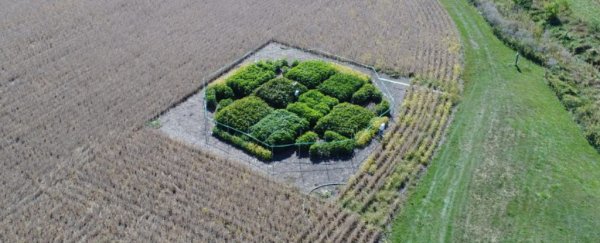Scientists have fixed a natural flaw in photosynthesis, and as a result have boosted plant productivity by an incredible 40 percent compared to wild relatives.
Photosynthesis is the chemical reaction that lets plants turn sunlight and carbon dioxide into food, and this new hack could result in enough calories to help feed another 200 million people on our planet, from the same volume of crops.
As of now, the fix has only been applied to tobacco plants, so we're a long way off using this to boost our food supply. But it's an incredibly promising first step.
So what is this 'glitch' that needed fixing? It's a little-known step in photosynthesis known as photorespiration.
"We could feed up to 200 million additional people with the calories lost to photorespiration in the Midwestern US each year," says principal investigator Donald Ort from the University of Illinois Carl R. Woese Institute for Genomic Biology.
"Reclaiming even a portion of these calories across the world would go a long way to meeting the 21st century's rapidly expanding food demands."
To understand what goes wrong, you need to understand a little about the haphazard process of evolution. In the immortal words of Dr Ian Malcolm in the sci-fi classic Jurassic Park, "Life finds a way". What he didn't say is sometimes that way is an inefficient hot mess.
To be fair, evolution does what it can under the circumstances. Like a grad student keeping one eye on summer break, it does just enough to pass. Anything more is a wasted effort, after all.
For many plants, including rice and soybeans, when it comes to photosynthesis, it's a bare pass. We're talking a begrudging C-.
One of the most clumsy parts is a key step involving the enzyme ribulose-1,5-bisphosphate carboxylase-oxygenase (RuBisCO), which wedges a carbon dioxide onto the compound ribulose-1,5-bisphosphate (RuBP).
Roughly 20 percent of the time, RuBisCO mistakes oxygen for the all-important carbon dioxide molecule.(Fun fact: RuBisCO is widely regarded as the most abundant protein on the planet)
Not only is this a wasted opportunity, the result of this glitch reaction is glycolate and ammonia – two toxic compounds that need to be swiftly dealt with before they cause too much damage.
Fortunately plants have evolved a way to rid themselves of this poison, called photorespiration. They don't mind spending a portion of their energy on this vital recycling process if it helps them survive.
But when it comes to growing them as a food source, we certainly do.
"It costs the plant precious energy and resources that it could have invested in photosynthesis to produce more growth and yield," says lead author and molecular biologist Paul South with the US Department of Agriculture Agricultural Research Service.
Rice, wheat, and soybeans all suffer from this need to clear out toxic buildup. Not only do they happen to be three of the four crops our world's population relies on for most our calories, we can expect their yield to drop in the future thanks to global warming.
"RuBisCO has even more trouble picking out carbon dioxide from oxygen as it gets hotter, causing more photorespiration," says co-author Amanda Cavanagh from the University of Illinois.
There have been numerous efforts over the years to find ways to force crop plants into avoiding the need to detox.
Many have involved finding the most efficient photorespiration approaches taken by other organisms, including various algae and bacteria.
This latest effort is called Realizing Increased Photosynthetic Efficiency (RIPE), and its approach was to select genes from elsewhere and test them out.
A handful came from the bacterium E. coli's glycolate oxidation pathway. A second version used a gene for catalase also from E. coli, and some for a glycolate oxidase and malate synthase from plants.
Subject number three used a plant malate synthase gene and a green algal gene for glycolate dehydrogenase.
These were used in conjunction with other genetic tweaks to find the most energy efficient pathway among 17 different constructs.
The third photorespiration pathway was the one that stood out from the rest in final results, with metabolic activity surging more than 40 percent compared with controls. This gained energy translates into bigger yields.
It remains to be seen whether these same efficiency boosts will be translated to other crops, but the researchers are working on it.
Life doesn't always find a way. But if we're to get food to where it's needed in the future, science will have to.
This research was published in Science.
